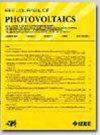用于高温钝化触点的PECVD纳米碳化硅
IF 2.6
3区 工程技术
Q3 ENERGY & FUELS
引用次数: 0
摘要
本研究探讨了纳米晶碳化硅(nc-SiC)薄膜作为高效太阳能电池透明钝化触点的潜力。采用等离子体增强化学气相沉积技术制备了高氢自由基密度的nc-SiC薄膜。研究了磷掺杂和热处理对薄膜结构、组成和电性能的影响。掺杂的增加降低了接触电阻,但也对开路电压($iV_{\text{oc}}$)产生了负面影响。我们确定了一组在电导率和钝化之间提供折衷的参数,导致纹理表面上的最大$iV_{\text{oc}}$为708 mV,接触电阻约为100 $\mathrm{m}\mathrm{\Omega}\mathrm{c}\mathrm{m}^{2}\,$。此外,与多晶硅(poly- si)和晶体硅(c-Si)相比,nc-SiC具有优越的紫外线透明度,吸收系数为3\ × 10^{5}\;\text{cm}^{-1}$在350 nm,低于典型的$1\乘以10^{6}\;\text{cm}^{-1}$用于poly-Si和c-Si。本文章由计算机程序翻译,如有差异,请以英文原文为准。
nc-SiC by PECVD for High-Temperature Passivating Contacts
This work investigates the potential of nanocrystalline silicon carbide (nc-SiC) films as transparent passivating contacts for high-efficiency solar cells. A plasma-enhanced chemical vapor deposition process for high hydrogen radical density was developed to fabricate nc-SiC films. The influence of phosphorus (P) doping and thermal treatment on the structural, compositional, and electrical properties of these films was investigated. Increased doping reduced the contact resistance but also negatively affected the open circuit voltage ($iV_{\text{oc}}$ $iV_{\text{oc}}$ $\mathrm{m}\mathrm{\Omega }\mathrm{c}\mathrm{m}^{2}\,$ $3\times 10^{5}\; \text{cm}^{-1}$ $1\times 10^{6}\; \text{cm}^{-1}$
求助全文
通过发布文献求助,成功后即可免费获取论文全文。
去求助
来源期刊

IEEE Journal of Photovoltaics
ENERGY & FUELS-MATERIALS SCIENCE, MULTIDISCIPLINARY
CiteScore
7.00
自引率
10.00%
发文量
206
期刊介绍:
The IEEE Journal of Photovoltaics is a peer-reviewed, archival publication reporting original and significant research results that advance the field of photovoltaics (PV). The PV field is diverse in its science base ranging from semiconductor and PV device physics to optics and the materials sciences. The journal publishes articles that connect this science base to PV science and technology. The intent is to publish original research results that are of primary interest to the photovoltaic specialist. The scope of the IEEE J. Photovoltaics incorporates: fundamentals and new concepts of PV conversion, including those based on nanostructured materials, low-dimensional physics, multiple charge generation, up/down converters, thermophotovoltaics, hot-carrier effects, plasmonics, metamorphic materials, luminescent concentrators, and rectennas; Si-based PV, including new cell designs, crystalline and non-crystalline Si, passivation, characterization and Si crystal growth; polycrystalline, amorphous and crystalline thin-film solar cell materials, including PV structures and solar cells based on II-VI, chalcopyrite, Si and other thin film absorbers; III-V PV materials, heterostructures, multijunction devices and concentrator PV; optics for light trapping, reflection control and concentration; organic PV including polymer, hybrid and dye sensitized solar cells; space PV including cell materials and PV devices, defects and reliability, environmental effects and protective materials; PV modeling and characterization methods; and other aspects of PV, including modules, power conditioning, inverters, balance-of-systems components, monitoring, analyses and simulations, and supporting PV module standards and measurements. Tutorial and review papers on these subjects are also published and occasionally special issues are published to treat particular areas in more depth and breadth.
 求助内容:
求助内容: 应助结果提醒方式:
应助结果提醒方式:


